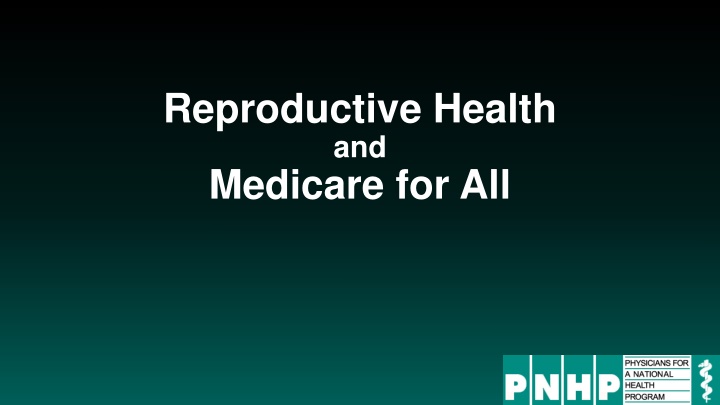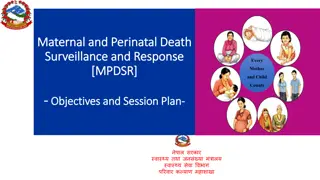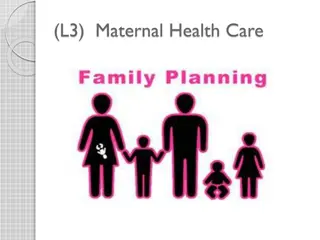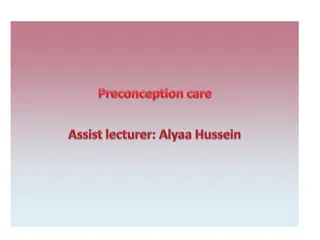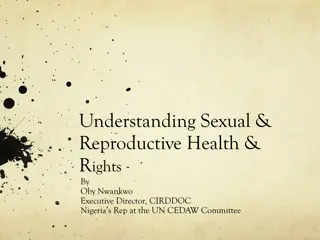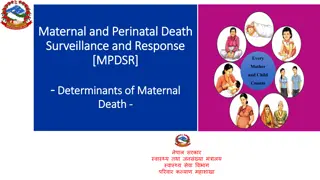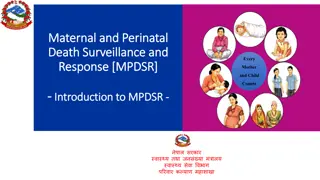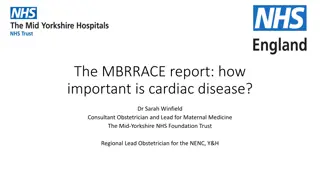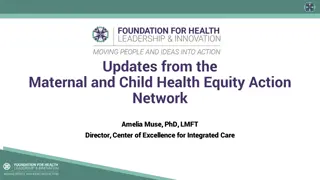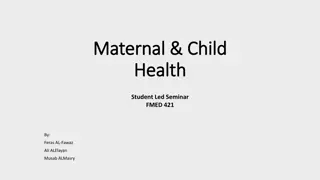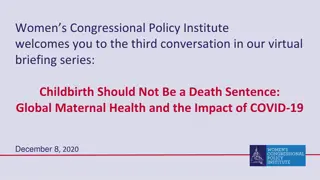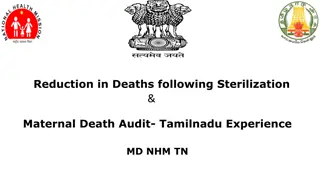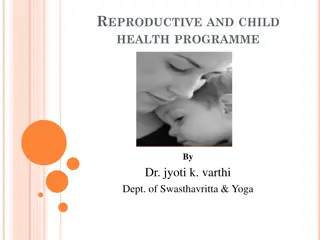Challenges in Reproductive Health and Maternal Care in the U.S.
Reproductive health and maternal mortality rates in the United States have raised concerns, with significant disparities across racial and economic lines. Maternal mortality has surged, with preventable deaths comprising a high percentage. Financial barriers hinder access to care, leading to skipped medical appointments and difficulty in paying bills. OB-GYNs frequently cite cost issues, especially affecting low-income patients, highlighting a pressing need for comprehensive healthcare reform.
Download Presentation

Please find below an Image/Link to download the presentation.
The content on the website is provided AS IS for your information and personal use only. It may not be sold, licensed, or shared on other websites without obtaining consent from the author.If you encounter any issues during the download, it is possible that the publisher has removed the file from their server.
You are allowed to download the files provided on this website for personal or commercial use, subject to the condition that they are used lawfully. All files are the property of their respective owners.
The content on the website is provided AS IS for your information and personal use only. It may not be sold, licensed, or shared on other websites without obtaining consent from the author.
E N D
Presentation Transcript
Reproductive Health and Medicare for All
U.S. Maternal Mortality Crisis 33 Maternal deaths per 100,000 live births 11 10 8 7 7 5 4 4 3 2 NOR AUS GER NET SWE SWI NZ FRA UK CAN US Maternal mortality: Death while pregnant or within 42 days of the end of pregnancy, irrespective of the duration and site of the pregnancy, from any cause related to or aggravated by the pregnancy or its management, but not from accidental or incidental causes. Used by the World Health Organization (WHO) in international comparisons. Date for 2021 or 2020 where available. Source: Trends in maternal mortality 2000 to 2020: estimates by WHO, UNICEF, UNFPA, World Bank Group and UNDESA/Population Division
Maternal Mortality More Than Quadrupled in U.S. 2021 = 33 Pregnancy -related deaths per 100,000 live births 1987 = 7 1987 1992 1997 2002 2007 2012 2017 2021 Pregnancy-related death: Death during pregnancy or within one year of the end of pregnancy from a pregnancy complication, a chain of events initiated by pregnancy, or the aggravation of an unrelated condition by the physiologic effects of pregnancy. This CDC measure is used in the U.S. only. https://www.cdc.gov/nchs/data/hestat/maternal-mortality/2021/maternal-mortality-rates-2021.htm;
Maternal Mortality Compounded by Racial Inequities 70 Maternal deaths per 100,000 live births (2021) 28 27 White Hispanic Black Hoyert DL. Maternal mortality rates in the United States, 2021. NCHS Health E-Stats. 2023. DOI: https://dx.doi.org/10.15620/cdc:124678 Accessed Sept. 6, 2023
Maternal Mortality Is a Solvable Problem Preventable 84% 84% of U.S. Maternal Deaths are Preventable https://www.cdc.gov/reproductivehealth/maternal-mortality/erase-mm/data-mmrc.html
U.S. Women Already Behind on Care 38% of women skipped medical care due to costs in past year. 44% of women report serious problems paying medical bills in past year. https://www.commonwealthfund.org/publications/issue-briefs/2018/dec/womens-health-us-compared-ten-other-countries#append4 Data for 2018.
Cost is Barrier to Reproductive Care 92% % of OB-GYNs reporting cost issues for patients 53% Cost of reproductive care is burden for low-income patients Cost of treatment comes up always or often https://www.kff.org/womens-health-policy/report/obgyns-and-the-provision-of-sexual-and-reproductive-health-care-key- findings-from-a-national-survey/
Many cant afford contraceptive care 100% 80% % of women not using preferred method of birth control 60% 40% 27% 20% 25% 0% Uninsured Women Low-income Women https://www.kff.org/womens-health-policy/issue-brief/womens-sexual-and-reproductive-health-services-key-findings- from-the-2020-kff-womens-health-survey/
High costs = less effective contraceptives Long-acting reversible 15% Short-acting reversible 25% % method used by women age 18 49 at risk for unintended pregnancy (2017-2019) NO contraceptive 30% Barrier 30% https://www.cdc.gov/mmwr/volumes/70/wr/mm7025a2.htm
Commercial Insurance = Barriers to Contraceptive Care May only cover ONE product in each category of contraceptive Must prove contraceptive is medically necessary 31% of pill users missed days because of insurance delays https://khn.org/news/article/contraception-free-options-for-women-cost-sharing/ https://www.kff.org/womens-health-policy/issue-brief/womens-sexual-and-reproductive-health-services-key-findings- from-the-2020-kff-womens-health-survey/
Doesnt the ACA Require Contraceptive Coverage? Plans that were grandfathered in Religious nonprofits Companies that object to contraceptive care https://www.kff.org/report-section/ehbs-2019-section-13-grandfathered-health-plans/ https://www.commonwealthfund.org/blog/2020/supreme-court-excuses-organizations-religious-or-moral-objections- covering-workers-birth
U.S.: High Rate of Unintended Pregnancy Intended pregnancy 54% % of Intended vs. Unintended Pregnancies in U.S. Unintended pregnancy 46% https://www.guttmacher.org/regions/northern-america/united-states
Higher Rate of Unintended Pregnancy for Low-Income Americans 60% % of Unintended Pregnancies in U.S. by income level 52% 30% 200%+ of Poverty 100-200% of Poverty Below Poverty Line https://www.nejm.org/doi/full/10.1056/nejmsa1506575
Providing low-cost contraceptive services to 1,000 women prevents: 288 unplanned pregnancies 141 unplanned births 104 elective abortions https://www.guttmacher.org/report/contraceptive-needs-and-services-2014-update#6
22 States Ban or Restrict Abortion Care Source: New York Times https://www.nytimes.com/interactive/2022/us/abortion-laws-roe-v-wade.html
Texas Abortion Ban Made Trip to Legal Abortion Provider 14x longer 247 One-way driving distance (miles) to legal abortion provider 17 Without Ban With Ban Data from: Impact of Texas Abortion Ban: A 14-Fold Increase in Driving Distance to Get an Abortion [Internet]. Guttmacher Institute. 2021 [cited 2021 Oct 23];Available from: https://www.guttmacher.org/article/2021/08/impact-texas-abortion-ban-14-fold- increase-driving-distance-get-abortion
Travel Time to Nearest Abortion Provider Reproductive Age Females >60 Minutes from Abortion Facility Mean Travel Time (Minutes) 100 33% 15% 28 Pre-Dobbs Post-Dobbs Pre-Dobbs Post-Dobbs Data from: Rader B, Upadhyay UD, Sehgal NKR, Reis BY, Brownstein JS, Hswen Y. Estimated Travel Time and Spatial Access to Abortion Facilities in the US Before and After the Dobbs v Jackson Women s Health Decision. JAMA [Internet]. 2022 Nov 1 [cited 2022 Nov 2]; Available from: https://doi.org/10.1001/jama.2022.20424
Travel Time to Nearest Abortion Provider 7.2 hours 7.0 hours Increase in travel time to closest legal abortion provider 7 million reproductive- aged women in Texas and Louisiana Texas Louisiania Data from: Rader B, Upadhyay UD, Sehgal NKR, Reis BY, Brownstein JS, Hswen Y. Estimated Travel Time and Spatial Access to Abortion Facilities in the US Before and After the Dobbs v Jackson Women s Health Decision. JAMA [Internet]. 2022 Nov 1 [cited 2022 Nov 2]; Available from: https://doi.org/10.1001/jama.2022.20424
TX: Change in Abortion Rate as Function of Distance to Nearest Legal Provider 50-100 miles 100-150 miles 150-200 miles 200+ miles Percentage change in abortions -16% -28% -38% -44% Note: Reference = <50 miles Data from: Lindo JM, Myers CK, Schlosser A, Cunningham S. How Far Is Too Far? New Evidence on Abortion Clinic Closures, Access, and Abortions. J Human Resources. 2020 Oct 2;55(4):1137 60. Estimates generated from difference-in- difference model examining implementation of Texas law SB8, which led to closure of almost half of clinics in the state.
One in 14 women self-induce abortion without medical assistance
Abortion Bans = Maternal Mortality 38% Increase in State s Maternal Mortality Rate 8% Closure of clinics Restrictions on gestational age https://www.ajpmonline.org/article/S0749-3797(19)30419-2/fulltext
Abortion Bans = Maternal Mortality 29 Maternal Mortality per 100,000 (2017) 16 States that protect abortion access States that restrict abortion access https://www.contraceptionjournal.org/article/S0010-7824(21)00090-1/fulltext
Elimination of Termination as Treatment for Previable Premature Rupture Of Membranes (PPROM)
Texas Abortion Ban: Dangerous Consequences for Pregnant People Morbidity rate among pregnant women <22 weeks with previable PROM (2 Texas hospitals) 57% 36% 18% 7% 4% Chorioamnionitis (infection of amniotic fluid) Placental Abruption ICU Blood Composite Morbidity Transfusion Data from: Nambiar A, Patel S, Santiago-Munoz P, Spong CY, Nelson DB. Maternal morbidity and fetal outcomes among pregnant women at 22 weeks gestation or less with complications in two Texas hospitals after legislation on abortion. American Journal of Obstetrics and Gynecology. 2022 Jul;S0002937822005361. Selected measures.
Medicare for All = Reproductive Care for All Covers everybody for all medically necessary care, including contraception, prenatal and postnatal care, and abortion care. Coverage is lifelong with no interruptions in care. Provides free choice of any hospital and provider. Care is free at the point of service with no copays or deductibles.
Medicare for All Improves Reproductive Health Care Today s Problems High rate of maternal mortality Lifelong coverage for all medically necessary services, including preconception, prenatal, and postnatal care High rate of unintended pregnancy Covers all FDA-approved contraceptives without costs, empowering patients to choose methods that work best Dangerous state-level abortion restrictions Provides abortion care without cost, regardless of location Employer opposition to contraceptive care Keeps reproductive health decisions between individuals and their doctors Commercial insurance barriers to care Covers all reproductive care without costs, preapprovals, or denials
